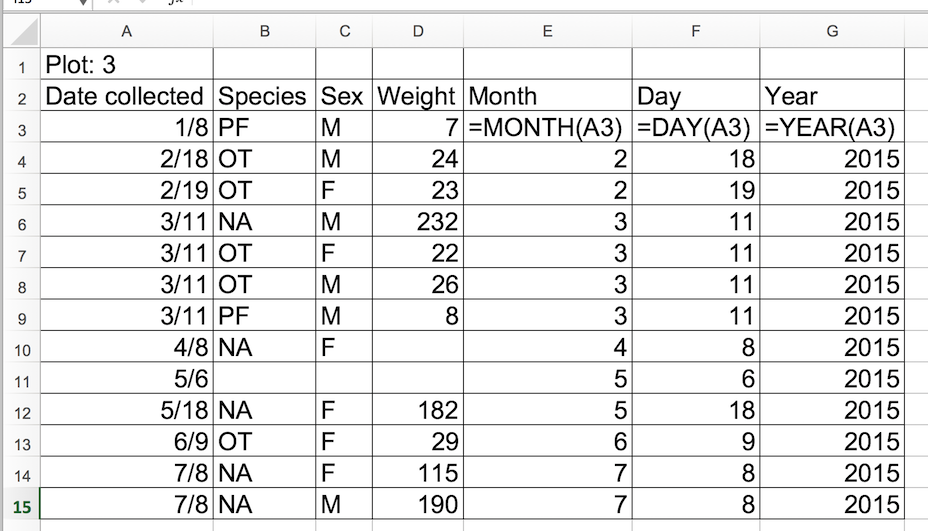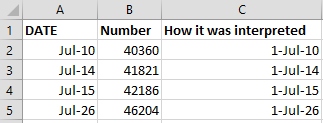Dates as data
Last updated on 2023-05-25 | Edit this page
Overview
Questions
- What are good approaches for handling dates in spreadsheets?
Objectives
- Describe how dates are stored and formatted in spreadsheets.
- Describe the advantages of alternative date formatting in spreadsheets.
- Demonstrate best practices for entering dates in spreadsheets.
Dates in spreadsheets can be a problem. For one thing, dates are stored in a single column. While this seems the most natural way to record dates, it actually is not best practice. A spreadsheet application will display the dates in a seemingly correct way (to a human observer) but how it actually handles and stores the dates may be problematic.
In particular, please remember that DATE functions that are valid for a given spreadsheet program (be it LibreOffice Calc, Microsoft Excel, OpenOffice, Gnumeric, etc.) are usually guaranteed to be compatible only within the same family of products. Most of the images of spreadsheets in this lesson come from Microsoft Excel, run on a Mac or on Windows. Regardless of your spreadsheet, if you will later need to export the data and need to conserve the timestamps, you are better off handling them using one of the solutions discussed below.
One of the big problems with Excel is it can turn things that aren’t dates into dates, for example gene/protein names or identifiers like MAR1, DEC1, OCT4 will be changed to dates, and you cannot retreive the original name or identifier (except manually). So if you avoid the date format overall, it’s easier to work with these types of data. When you must work with dates, here is how to do it efficiently.
Exercise
Challenge: pulling month, day and year out of dates
- Let’s create a tab called
datesin our data spreadsheet and copy the ‘plot 3’ table from the2014tab (that contains the problematic dates). - Let’s extract month, day and year from the dates in the
Date collectedcolumn into new columns. For this we can use the following built-in Excel functions:
YEAR()
MONTH()
DAY()
(Make sure the new columns are formatted as a number and not as a date.)
You can see that even though we expected the year to be 2014, the year is actually 2015. What happened here is that the field assistant who collected the data for year 2014 initially forgot to include their data for ‘plot 3’ in this dataset. They came back in 2015 to add the missing data into the dataset and entered the dates for ‘plot 3’ without the year. Excel automatically interpreted the year as 2015 - the year the data was entered into the spreadsheet and not the year the data was collected. Thereby, the spreadsheet program introduced an error in the dataset without the field assistant realising.
 {alt=‘dates, exersize
1’ .output}
{alt=‘dates, exersize
1’ .output}
Exercise
Challenge: pulling hour, minute and second out of the current time
Current time and date are best retrieved using the functions
NOW(), which returns the current date and time, and
TODAY(), which returns the current date. The results will
be formatted according to your computer’s settings.
- Extract the year, month and day from the current date and time
string returned by the
NOW()function. - Calculate the current time using
NOW()-TODAY(). - Extract the hour, minute and second from the current time using
functions
HOUR(),MINUTE()andSECOND(). - Press
F9to force the spreadsheet to recalculate theNOW()function, and check that it has been updated.
- To get the year, type
=YEAR(NOW())into any cell in your spreadsheet. To get the month, type=MONTH(NOW()). To get the day, type=DAY(NOW()). - Typing
=NOW()-TODAY()will result in a decimal value that is not easily human parsable to a clock-based time. You will need to use the strategies in the third part of this challenge to convert this decimal value to readable time. - To extract the hour, type
=HOUR(NOW()-TODAY())and similarly for minute and second.
Preferred date format
It is much safer to store dates with YEAR, MONTH, DAY in separate columns or as YEAR and DAY-OF-YEAR in separate columns.
Note: Excel is unable to parse dates from before 1899-12-31, and will thus leave these untouched. If you’re mixing historic data from before and after this date, Excel will translate only the post-1900 dates into its internal format, thus resulting in mixed data. If you’re working with historic data, be extremely careful with your dates!
Excel also entertains a second date system, the 1904 date system, as the default in Excel for Macintosh. This system will assign a different serial number than the 1900 date system. Because of this, dates must be checked for accuracy when exporting data from Excel (look for dates that are ~4 years off).
Date formats in spreadsheets
Spreadsheet programs have numerous “useful features” which allow them to handle dates in a variety of ways.

But these “features” often allow ambiguity to creep into your data. Ideally, data should be as unambiguous as possible.
Dates stored as integers
The first thing you need to know is that Excel stores dates as numbers - see the last column in the above figure. Essentially, it counts the days from a default of December 31, 1899, and thus stores July 2, 2014 as the serial number 41822.
(But wait. That’s the default on my version of Excel. We’ll get into how this can introduce problems down the line later in this lesson. )
This serial number thing can actually be useful in some circumstances. By using the above functions we can easily add days, months or years to a given date. Say you had a sampling plan where you needed to sample every thirty seven days. In another cell, you could type:
=B2+37And it would return
8-Augbecause it understands the date as a number 41822, and
41822 + 37 = 41859 which Excel interprets as August 8,
2014. It retains the format (for the most part) of the cell that is
being operated upon, (unless you did some sort of formatting to the cell
before, and then all bets are off). Month and year rollovers are
internally tracked and applied.
Note Adding years and months and days is slightly trickier because we need to make sure that we are adding the amount to the correct entity.
- First we extract the single entities (day, month or year)
- We can then add values to do that
- Finally the complete date string is reconstructed using the
DATE()function.
As for dates, times are handled in a similar way; seconds can be directly added but to add hour and minutes we need to make sure that we are adding the quantities to the correct entities.
Which brings us to the many different ways Excel provides in how it displays dates. If you refer to the figure above, you’ll see that there are many ways that ambiguity creeps into your data depending on the format you chose when you enter your data, and if you’re not fully aware of which format you’re using, you can end up actually entering your data in a way that Excel will badly misinterpret and you will end up with errors in your data that will be extremely difficult to track down and troubleshoot.
Exercise
What happens to the dates in the dates tab of our
workbook if we save this sheet in Excel (in csv format) and
then open the file in a plain text editor (like TextEdit or Notepad)?
What happens to the dates if we then open the csv file in
Excel?
- Click to the
datestab of the workbook and double-click on any of the values in theDate collectedcolumn. Notice that the dates display with the year 2015. - Select
File -> Save Asin Excel and in the drop down menu for file format selectCSV UTF-8 (Comma delimited) (.csv). ClickSave. - You will see a pop-up that says “This workbook cannot be saved in
the selected file format because it contains multiple sheets.” Choose
Save Active Sheet. - Navigate to the file in your finder application. Right click and
select
Open With. Choose a plain text editor application and view the file. Notice that the dates display as month/day without any year information. - Now right click on the file again and open with Excel. Notice that
the dates display with the current year, not 2015.
As you can see, exporting data from Excel and then importing it back into Excel fundamentally changed the data once again!
Note
You will notice that when exporting into a text-based format (such as
CSV), Excel will export its internal date integer instead of a useful
value (that is, the dates will be represented as integer numbers). This
can potentially lead to problems if you use other software to manipulate
the file.
Storing dates as YEAR, MONTH, DAY
Storing dates in YEAR, MONTH, DAY format helps remove this ambiguity. Let’s look at this issue a bit closer.
For instance this is a spreadsheet representing insect counts that were taken every few days over the summer, and things went something like this:

If Excel was to be believed, this person had been collecting bugs in the future. Now, we have no doubt this person is highly capable, but I believe time travel was beyond even their grasp.
Entering dates in one cell is helpful but due to the fact that the spreadsheet programs may interpret and save the data in different ways (doing that somewhat behind the scenes), there is a better practice.
In dealing with dates in spreadsheets, separate date data into separate fields (day, month, year), which will eliminate any chance of ambiguity.
Storing dates as YEAR, DAY-OF-YEAR
There is also another option. You can also store dates as year and day of year (DOY). Why? Because depending on your question, this might be what’s useful to you, and there is practically no possibility for ambiguity creeping in.
Statistical models often incorporate year as a factor, or a categorical variable, rather than a numeric variable, to account for year-to-year variation, and DOY can be used to measure the passage of time within a year.
So, can you convert all your dates into DOY format? Well, in Excel, here’s a useful guide:

Storing dates as a single string
Another alternative could be to convert the date string into a single
string using the YYYYMMDD format. For example the date
March 24, 2015 would become 20150324. This
option also works for datetimes using the YYYYMMDDhhmmss
format. So the datetime March 24, 2015 17:25:35 would
become 20150324172535, where:
YYYY: the full year, i.e. 2015
MM: the month, i.e. 03
DD: the day of month, i.e. 24
hh: hour of day, i.e. 17
mm: minutes, i.e. 25
ss: seconds, i.e. 35
Such strings will be correctly sorted in ascending or descending order, and by knowing the format they can then be correctly processed by the receiving software.
Key Points
- Treating dates as multiple pieces of data rather than one makes them easier to handle.
